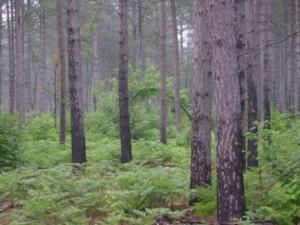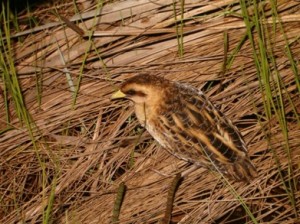USE OF FIRE FOR THE RESTORATION OF WILDLIFE COMMUNITIES IN THE NORTHERN LAKE STATES
Land use change and the removal of fire have affected many ecosystems throughout the northern Lake States, including Michigan, Wisconsin, and Minnesota. A number of these ecosystem types, such as mixed-pine forests and open wetlands, are dependent on fire to maintain composition, structure, and function. The Lake States Fire Science Consortium (LSFSC) is a network of fire managers and scientists interested in the fire-dependent ecosystems of the northern Lake States region (http://www.lakestatesfiresci.net/). To address existing information gaps regarding the wildlife community that inhabit fire-dependent ecosystems (Miesel 2013), the LSFSC has initiated an information exchange to enhance the existing understanding of natural disturbances, vegetation, and wildlife and the integration of this knowledge into restoration and conservation efforts.
Wildlife species whose regional distribution and abundance were historically highly associated with fire-dependent ecosystems can themselves be considered fire-dependent because of their preferences for vegetation patterns that resulted from fire. Some charismatic species, such as the federally endangered Kirtland’s Warbler (Setophaga kirtlandii), have been relatively well studied. However, much less is known about other fire-dependent wildlife species in the northern Lake States, such as the Red Crossbill (Loxia curvirostra) and Black-backed Woodpecker (Picoides arcticus). For many land management professionals lists of which wildlife species were historically fire-dependent wildlife do not exist. Developing such lists is critical to eventually filling in research gaps on fire-dependent species and facilitating an exchange of present knowledge that will aid restoration and conservation efforts of fire-dependent ecosystems.
Currently, the LSFSC is mid-way through a three-year effort (2013-2015) to increase the knowledge base needed for managing wildlife species associated with fire-dependent ecosystems in the northern Lake States. LSFSC has developed lists of fire-dependent wildlife species which include information on conservation status from state wildlife action plans and species at risk lists. These lists were provided to resource managers and scientists for critique. The edited lists indicated that 46 bird species, 15 mammal species, and 13 reptile species were associated with fire-dependent ecosystems. Of these fire-dependent wildlife species, 22 were listed as State Threatened or Endangered (Table 1), which highlights the importance of fire-dependent ecosystems for wildlife restoration in the northern Lake States.
Table 1. Current state conservation status of selected fire-dependent wildlife species in Michigan (Michigan DNR 2005, Michigan Natural Features Inventory 2013), Wisconsin (Wisconsin DNR 2012a, 2012b) and Minnesota (Minnesota DNR 2006). SGCN – species of greatest conservation need are those with low and/or declining populations and are in need of conservation action.

Table 1: Current state conservation status of selected fire-dependent wildlife species in Michigan (Michigan DNR 2005, Michigan Natural Features Inventory 2013), Wisconsin (Wisconsin DNR 2012a, 2012b) and Minnesota (Minnesota DNR 2006). SGCN – species of greatest conservation need are those with low and/or declining populations and are in need of conservation action.
Moving forward the LSFSC plans to conduct interviews with land managers and wildlife professionals to: 1) evaluate what they are doing in terms of inventory, monitoring, and research; 2) identify potential areas for collaboration with LSFSC; and 3) gather feedback on the needs of managers and researchers that the LSFSC might be able to meet. LSFSC investigators also plan to create maps with wildlife range and distribution data and overlay them with land ownership patterns to identify regional hotspots of fire-dependent species occurrence. The results of these interviews and mapping will be shared through outreach efforts, such as an organized session at the annual Midwest Wildlife Conference in February 2015, to make stakeholders aware of this new information and the shared interests of different organizations and professionals. If you are interested in learning more about this research effort and/or the LSFSC contact Dr. Greg Corace (Seney National Wildlife Refuge, email Greg_Corace@fws.gov; phone 906-586-9851 extension 14).
References
Michigan DNR. 2005. Michigan’s wildlife action plan SGCN status and species-specific issues. Michigan Department of Natural Resources.
Michigan Natural Features Inventory. 2013. Michigan’s special animals. Retrieved from http://mnfi.anr.msu.edu/data/specialanimals.cfm/
Miesel, J. 2013. Lake States Fire Science Consortium knowledge gaps assessment: increasing awareness and accessibility of regional results by management and research communities. Unpublished data. Lake States Fire Science Consortium.
Minnesota DNR. 2006. Tomorrow’s habitat for the wild and rare: an action plan for Minnesota wildlife set of species in greatest conservation need. Minnesota Department of Natural Resources.
Wisconsin DNR. 2012a. Species of greatest conservation need. Wisconsin Department of Natural Resources. Retrieved from http://dnr.wi.gov/topic/wildlifehabitat/profiles.asp.
Wisconsin DNR. 2012b. Wisconsin natural heritage working list. Wisconsin Department of Natural Resources.
By: Shelby A. Weiss, Applied Sciences Program, Seney National Wildlife Refuge
Email: shlbweiss@gmail.com



